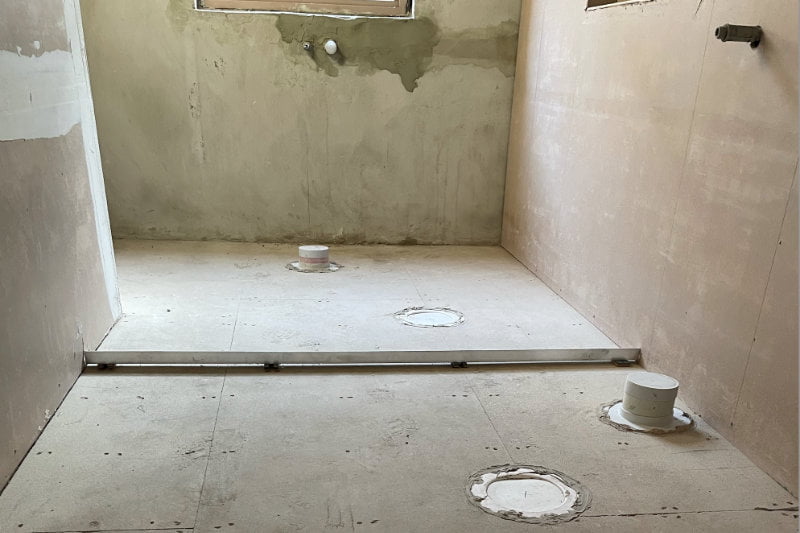Magnum Board delivers a lining option that lives up to the higher safety standards of most timber buildings.
We’re all familiar with the joys of working with timber: it’s a fairly easy and forgiving building material and, aside from not inhaling dust and taking basic protective precautions, there are few worries around working with it.
McCormacks Australia has been supplying timber to the local market for over 20 years and recently added Magnum Board to their offer. The reasoning for the addition was simple: many of the lining boards on the market detract from the ease and safety of timber-framed building.
A large number of popular lining boards, particularly for walls and wet areas, are based on cement products. They’re heavy to work with and, worst of all, have a high silica content. This means the dust from cutting them represents a cancer risk not just to the people working with them, but to those nearby on site and anyone later coming in contact with contaminated areas and clothes.
Curtin University recently handed down the results of a study commissioned by the ACTU. It looked at the roughly 600,000 Australian workers currently exposed to silica dusts (only 4400 of them stonemasons working with reconstituted stone) and showed more than 10,000 of them were expected to develop lung cancers from exposure to silica dust. Additionally, 103,000 are expected to develop silicosis, which has varying degrees of impact on lung function.
Victoria has new OHS regulations designed to cut the risk, but they are not Australia-wide and too many workplaces either don’t understand the issue or think it’s only related to composite benchtops.
Substituting non-silica-based boards, like Magnum Board, removes the problem at its source. Made from magnesium oxide and wood fibres, with no harmful binding agents, it’s a very low-risk material that can be used for walls, floors and more, in wet or dry areas. And, unlike standard plasterboards, it stays strong when wet and will not grow mould, even after floods.
LIGHTWEIGHT AND STRONG
Robert D’Ambrosio, managing director of D’Ambrosio Construction Group, has been using Magnum Board on many of his recent builds. He appreciates the improved dust safety, but has more basic reasons behind his preference for the product.
“It’s just easy to work with,” D’Ambrosio says. “In terms of weight, compared to competitors’ materials, it’s so much easier on your body and on your tools. I use my standard Festool track saws with the vacuums and a composite blade and it cuts perfectly. It’s a pleasure to work with.”
D’Ambrosio is currently using Magnum Board on a $600,000 renovation and is in the process of testing it for use on a $2 million rooftop garden project. “We do a lot of lining and cladding,” he says. “We’ve used most of the products on the market: competitors’ cementitious boards, composites, plaster, recycled hardwood…
“The Magnum Board is easy to work with and it’s multifunctional. So instead of ordering a range of different products, you can do a single order and lay it where you would have used the old particleboard flooring and then transfer straight through to your wet areas.”
For the upcoming rooftop garden job, D’Ambrosio plans to use the board in conjunction with root repelling and waterproofing systems, so currently has the product out for testing with two waterproofing suppliers. “One’s already approved it and we’re just waiting to hear back from the other,” he says.
The one thing D’Ambrosio is baffled by is that magnesium oxide board isn’t used more widely. “I can’t believe it’s taken so long for a product like this to come to the market,” he says. “It’s been around in the US and New Zealand for a while, from what I’ve been told. I think Australia is a little bit behind. It might be up to the younger generation of builders like me to drive it, because we’re looking for the best option rather than sticking to what we know.”
With a price point around or below the alternatives, the switch to Magnum Board has been an easy choice.
“I think it’s like any tradesman, you’ve only got a short lifespan for your career,” D’Ambrosio says. “And if a product is half or two-thirds the weight of what you’ve been taught to use, why wouldn’t you use it?
Selling the change to his customers has been easy, too. “I’m a carpenter by trade, not just a builder,” says D’Ambrosio. “So I’m quite hands on. I try to avoid products that have negative impacts or come from companies that are doing the wrong things for the environment or the wider industry.
“A lot of my customers are really conscious of the same issues, so it’s something I can sell on. They really respond to stories like the Magnum Board linings and all the recycled and sustainable materials that I prefer to use.”
HEALTHY HOMES
“We brought Magnum Board to the Australian market as part of our focus on health-based building,” says Julia Hall, CEO of McCormacks Australia.
“But if builders are using it because it means they have less wear and tear on their bodies and tools at the end of the day, that’s another good reason!”
The health-based building standard was developed by Robin Curtis in New Zealand and aims to deliver dry, mould-free, well-ventilated and well-insulated homes that suit ANZ climates.
Magnum Board plays a central role in the standard. In itself, the product is CO2 negative and contains no toxins or other dangerous materials (magnesium oxide is a common health food supplement in its more refined form), but it’s the board’s qualities in a structure that really shine.
It’s mould- and insect-proof, non-combustible, vapour permeable – so your walls will breathe, but still has a high water resistance. In the US, it’s commonly used in flood-prone areas like Florida, because it can be simply hosed down and left in place after inundation, with no mould risk.
McCormacks supplies the product in a range of lining products, flooring underlay, weatherboard, rigid air barrier and more.
“What attracted us was the safety focus of the board, both for the homeowner, but also for the builders and tradies working on that home,” says Hall.
“Too often, building products are a danger to the people working with them, and we wanted to remove a major dust risk. The fact that we’ve ended up with a versatile, economical and extremely high-performance product is a bonus.”
For more information, visit www.mccormacksaustralia.com.au/magnumboard, www.dcgrp.com.au or www.healthbasedbuilding.com.au
Image: Magnum Board lining a wet area in this renovation.












